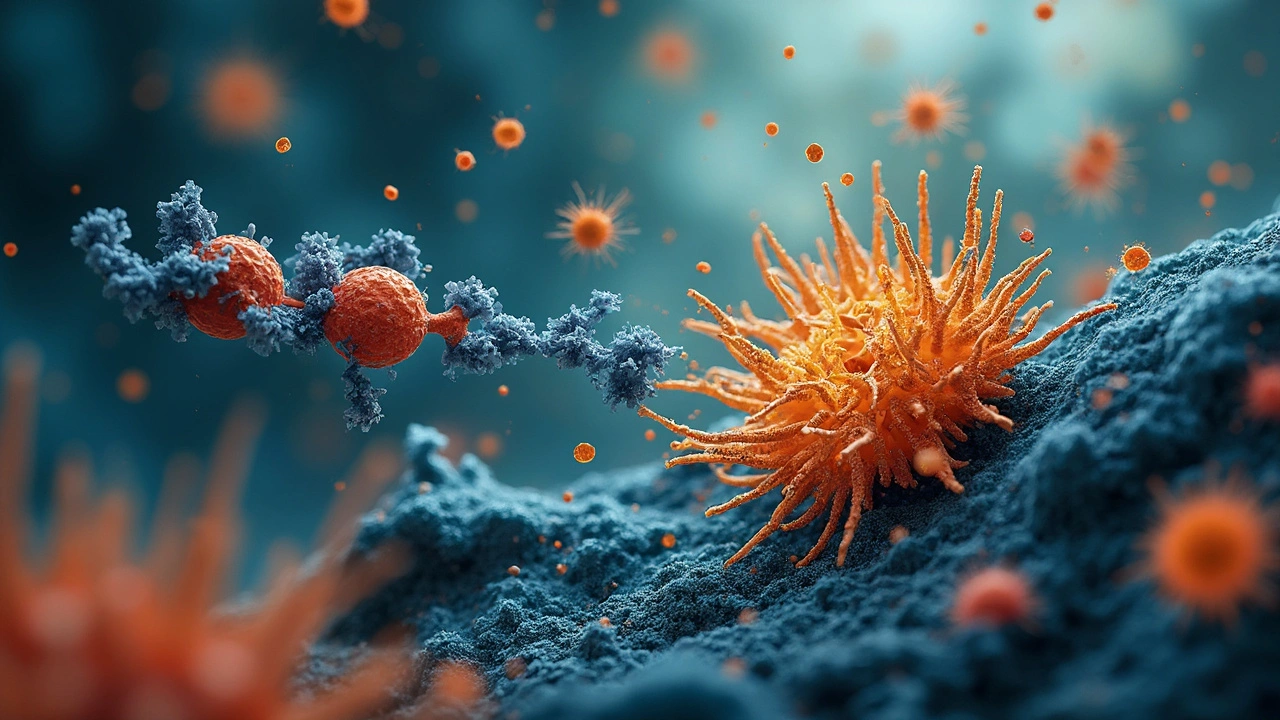It’s wild to think there’s a drug that can help save your toenails, your scalp, and even your peace of mind. If you’ve ever dealt with chronic ringworm or those "athlete’s foot just won’t quit" situations, you probably know how frustrating it can get. This is where Grifulvin V steps in—an old-school antifungal medicine with a surprising amount of grit. But there’s more to it than just popping a pill and moving on. Understanding how it works and playing it smart with your treatment can make all the difference.
What is Grifulvin V and What Makes It Special?
Grifulvin V is the brand name for griseofulvin, one of the earliest oral antifungal medicines. It was first approved by the FDA back in 1959, long before most of today’s modern antifungals were even on the radar. What sets Grifulvin V apart from antifungal creams and ointments is that it actually works from the inside out. Instead of trying to kill fungus directly on the surface, it targets fungal infections that live deep in your hair, skin, or nails—places that creams just can’t reach.
This is the go-to medication for stubborn infections caused by dermatophytes, which are those pesky fungi responsible for athlete’s foot (tinea pedis), ringworm (tinea corporis), and nail fungus (onychomycosis). If you’re picturing those circular red itchy rashes or crumbly, thickened toenails, you’re in the right zone. Grifulvin V disrupts how the fungus grows by messing with its cell walls. It actually binds to the keratin in your skin, hair, and nails, making it unfriendly territory for the fungi to grow and trickier for them to invade new skin as it heals.
One of the most interesting facts about Grifulvin V? It’s derived from a species of mold called Penicillium griseofulvum. That’s right—the same family as the famous Penicillin, though Grifulvin V targets fungi, not bacteria. It shows up on the World Health Organization’s List of Essential Medicines, mostly for its safety and effectiveness, especially in kids. Unlike some hardcore antifungals, this one’s gentle enough for long-term use in children, which is pretty rare in the world of infection-fighting drugs.
Most creams can’t make a dent in infections that hang out deep inside the nails or scalp because they simply don’t go deep enough. Grifulvin V shines here because it travels through your blood to target those hard-to-reach spots. This means you don’t have to keep up with the messiness or inconvenience of applying topical creams day and night.
If you’re comparing options, it’s worth knowing that Grifulvin V doesn’t take down every fungus in its path. It only works against certain types—the dermatophytes. Fungi such as Candida (responsible for yeast infections) are totally unaffected. This focused approach means it’s not a cure-all, but it also means less risk of disturbing your body’s normal, healthy bugs. For athletes, parents, and anyone prone to scalp or toenail fungus, Grifulvin V is still recommended in the latest dermatology guidelines as a trusted option.
Who Needs Grifulvin V and When To Consider It
Here’s the deal: most minor fungal infections on the skin respond pretty well to over-the-counter creams or sprays. But when infections keep coming back, or they nestle into places you just can’t reach, oral antifungals step up. Grifulvin V is usually prescribed for:
- Tinea capitis (scalp ringworm): Especially common in kids. Creams just don’t work for the scalp—studies show they can’t get through the hair follicles.
- Tinea unguium (nail fungus): Especially in toenails, where creams can’t penetrate.
- Body ringworm that’s widespread or keeps returning.
Pediatricians and dermatologists often pick Grifulvin V for kids because the safety data is solid and serious reactions are rare. Adults with thick nail fungal infections (think crumbly, yellowing, or deformed nails) might get a longer course, sometimes months. The same goes for immune-compromised folks or anyone who hasn’t responded to creams or jock-itch powders.
One interesting twist: Grifulvin V isn’t instantly fast. You need patience—the treatment course can last six weeks to several months, depending on the infection spot. It takes time because the drug doesn’t kill fungus directly; it prevents new growth, so you have to wait for fresh, healthy skin, hair, or nails to grow in. That’s why some people start feeling hopeful too soon and quit early. Stick it out, and results usually follow.
There are some situations where Grifulvin V isn’t a great choice. It’s not for everyone—anyone severely allergic to penicillin-type antibiotics should chat with their doctor first, even though cross-reactivity is rare. And since it only works on certain fungi, a skin swab (called a KOH prep or fungal culture) can help your provider make the right call. Pregnant and breastfeeding women should also ask, since griseofulvin isn’t recommended during pregnancy.

How to Take Grifulvin V: Tips for Best Results
If you were prescribed Grifulvin V, it’s not the kind of treatment you want to start-and-stop or take randomly. The medicine usually comes as a tablet or a liquid. Good news: taking it with a fatty meal (like whole milk or a bit of peanut butter toast) helps your body absorb it way better—this is one time when "take with food" is actual science, not just a formality on the label. Studies from the early 2000s showed absorption can double if you eat a fatty meal, which means faster, more reliable results.
Sticking with your full course is key. If your doctor says eight weeks, take all eight weeks. Stopping early means the fungus hasn’t been completely sidelined, and it can bounce back just as strong. Unlike antibiotics, missing a dose here and there isn’t likely to create "super fungi," but it does stall your healing and wastes early progress.
Daily routines help. Set a phone reminder or pair your dose with a meal you never skip to avoid the "Did I take it today?" dance. Some people prefer to use pillboxes or a sticky note on the fridge for extra assurance. Forgetting a single dose isn’t the end of the world—just take it when you remember unless it’s almost time for the next one (then skip the missed dose).
If you’re treating nail fungus, don’t expect huge changes overnight. Toenails grow about 1-2 mm each month, fingernails a bit faster. That’s why nail infections need months, sometimes up to six, for a full swap-out. Don’t get discouraged if things look slow in the beginning.
Couple tips from real-life users: If your doc gives you a liquid form, keep it in a cool, dark cupboard, and use the dosing spoon. Don’t mix it with juice; the fat from dairy or nut butter really does make a difference. Adding a probiotic or eating yogurt can help if your stomach feels off—some report mild upset, a little queasiness, or even a headache for the first few days, but these usually go away.
And don’t forget follow-ups. Your healthcare provider might want to see you several weeks in to check your skin or run a quick liver test—rare, but sometimes needed for longer treatments. Most people feel completely fine on Grifulvin V, but if you notice a swollen tongue, rash, or any signs of an allergic reaction, contact your provider right away.
Side Effects, Safety, and What to Watch Out For
One reason Grifulvin V sticks around after all these decades? The side effect profile is pretty mild compared to some newer antifungals. Most people do fine, but there are a few things to keep on your radar, especially with longer courses.
The most common complaints: headaches, mild stomach upset, feeling tired, or a bit dizzy. They’re not fun, but rarely dangerous, and often get better as your body gets used to the medicine. Some report mild rashes, and kids are more likely to experience upset tummies or loose stools. Rarely, there can be more serious effects like changes in liver enzymes or blood counts, so doctors monitor if treatment goes on for months.
If you love detailed info, here’s a quick glance at what the data says about safety and side effects:
| Side Effect | Likelihood |
|---|---|
| Headache | About 7% of users |
| Gastrointestinal upset | About 5% |
| Rash | Less than 1% |
| Liver enzyme changes | Very rare (less than 0.5%) |
Day-to-day, the most important thing is to avoid alcohol while you’re on Grifulvin V. The drug makes your body handle alcohol poorly—it can cause nausea, vomiting, and a sketchy flushing reaction, kind of like a nasty hangover. Women on estrogen-based birth control need extra caution; Grifulvin V can make the pill less effective, so a backup method (like condoms) is smart for the length of treatment plus one month after.
Safety in pregnancy is another biggie. Animal studies have linked griseofulvin to birth defects, and so doctors avoid it for pregnant women or those trying to conceive. It does show up in breast milk, so breastfeeding moms should talk through risks and benefits with their provider.
If you have liver disease, porphyria, lupus, or are allergic to penicillins/cephalosporins, let your doc know before starting Grifulvin V. Sometimes your doctor will order a baseline liver panel, especially if you’ll be using the drug for more than a month, and run a blood test partway through just to be sure everything’s looking good.

FAQs and Smart Strategies: Getting the Most from Grifulvin V
Got questions? You’re not alone. These are some of the most common things people ask when starting Grifulvin V:
- How long does it take to work? It depends on what you’re treating. Scalp ringworm usually clears in 4-8 weeks. Nail fungus may need 4-6 months, until healthy nail grows out. Body or foot ringworm clears in 2-6 weeks on average.
- What if I miss a dose? No need to panic. Take it as soon as you remember if it’s not too close to the next dose. Don’t double up.
- Can I use other remedies with Grifulvin V? Usually yes, especially antifungal creams for extra relief. Don’t mix with alcohol.
- Does it affect other medications? Yes! It can interact with warfarin, oral contraceptives, and barbiturates. Always give your complete med list to your provider.
- Is it safe for kids? Yes, the American Academy of Pediatrics recognizes it as a standard treatment for scalp ringworm.
- How can I prevent reinfection? Clean bedding and hats regularly, keep toenails short, don’t share personal grooming tools, and use antifungal sprays in your shoes if you’re treating foot fungus.
A smart extra tip: because Grifulvin V works by making new skin and nails less "fungus-friendly," keep the infected area clean and dry, and trim nails regularly if that’s where the trouble is. You can ask your doctor about adding a topical antifungal to knock down surface fungus while the oral drug works on deeper levels. If you’re prone to jock itch or athlete’s foot, rotating your footwear and showering right after sports helps reduce the odds of reinfection, especially in gyms or dorms.
Remember, an occasional side effect doesn’t mean the drug isn’t working—it means your body is adjusting. Keep open communication with your provider, write down any changes you notice, and value your patience. Every time someone finishes a full course of Grifulvin V and clears a nasty, stubborn infection, it’s a tiny little life victory.
The next time you or your loved ones wrangle with that “un-killable” rash or nail fungus, don’t just think creams or powders—sometimes, the best fix really does come from the inside out.
